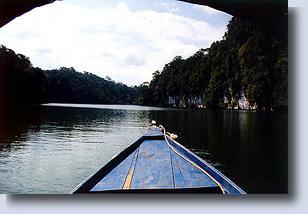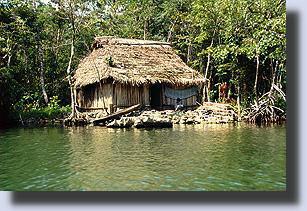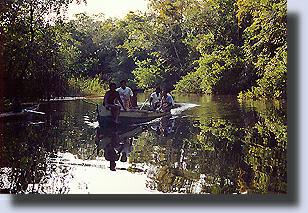|
Rio Dulce
Livingston, Guatemala
The photographs are thumbnails.
Took
a bus back to Chiquimula from
Esquipulas and caught another four-hour ride to Puerto Barrios.
Coming here was another spontaneous decision made the night
before last after speaking with a woman from Switzerland named
Andrea and another, Janne ("Yenna"), who is from Denmark. They
said that Puerto Barrios is like a dead end and, well, they were
not too far off the mark. It is not pretty, it is dusty and, so
far, the people seem, at least, very listless. I read that the
town fell into tropical torpor after the United Fruit Company
moved its headquarters out of here in the 1960's. And it looks
like it. However, the countryside coming here was brilliant
green with beech (for gum) and cocoa farms. It is 90° and humid.
  I came to Puerto Barrios to take a launch across the bay to Livingston,
which can only be reached by boat. It should be arriving in two hours. I had
heard of a boat tour out of Livingston up a river named Rio Dulce ("Sweet
River") which others, including Andrea and Janne, have said is really
magnificent.
I came to Puerto Barrios to take a launch across the bay to Livingston,
which can only be reached by boat. It should be arriving in two hours. I had
heard of a boat tour out of Livingston up a river named Rio Dulce ("Sweet
River") which others, including Andrea and Janne, have said is really
magnificent.
* *
*
After
a slow hour and one half on a tugboat-sized ship packed almost to
overflowing with people and costing Q3.50 (70¢ US), we arrived in
Livingston. It is tropical, hilly and different than any place I've been so
far. Even its name is strange in light of the names of other cities in
Guatemala like Quetzaltenango, Huehuetenango,
Totonicapán, etc. I think the name comes from the British who colonized
Belize, the country just to the north. The locals are a mix of descendants
of African (Garifuna) slaves, Mayan and European blood. They say the
Garifunas escaped from boats passing through here a couple hundred years
ago, settled in and, in some cases, intermarried with the local Mayan
people. I'm sure many also escaped the wrath of the plantations in Belize.
It looks like a great place for photographs.
* * *
Took
a boat tour up the Rio Dulce yesterday.
The trip lasted about 8 hours and cost Q40. People I had spoken with
previously said the ride stretched anywhere from 4 to 6 hours and cost Q60.
We definitely got a good deal. Went with 5 other people. Allison, Susan and
Lee are from the Yukon in Canada; Tony and Rachel are from England. I had
met Allison and Susan last week in Esquipulas. They are pretty tough
customers when it comes to purchasing anything and were responsible for
getting the price for each person down from Q60 to Q40. Ceasár, the captain,
feigned the commonly accepted displeasure throughout the bargaining process,
but finally agreed and we set out.
The boat is about 25 feet long and four feet
wide. It has 6 benches, which seat two each and an arched canvas canopy that
covers the benches. Sitting very low in the water, it is powered by an
outboard motor at the rear. We often drug our hands through the river as we
moved along on our adventure.
  Rio
Dulce is over a quarter of a mile wide. Over the millennia it has carved a
spectacular gorge in the mountains at the end of El Golfete and empties into
Bahia Amatique on the Gulf of Honduras. El Golfete is a long, huge lake-like
body of water between Rio Dulce and Lake Izabel to the southwest, which is
the largest lake in Guatemala. The river is only 12 km long and is
breath-taking, lined with lush tropical vegetation, cliffs and awe-inspiring
scenery. The thick jungle on its banks is full of the voices of monkeys and
many species of birds. White egrets perch in trees along its shores
searching for fish. Parrots, pelicans and other water birds are everywhere.
Narrow tributaries off the river twist and turn, leading to secluded
lagoons. Dwellings sprinkled along el Rio are constructed with walls
made of wooden planks or slender tree trunks and roofs of palm thatch. I was
told many crocodiles used to inhabit this complex ecosystem, but most have
been hunted off now. Water lilies grow in gigantic clusters here and there
and mangroves send their roots into the water at the shore. Rio
Dulce is over a quarter of a mile wide. Over the millennia it has carved a
spectacular gorge in the mountains at the end of El Golfete and empties into
Bahia Amatique on the Gulf of Honduras. El Golfete is a long, huge lake-like
body of water between Rio Dulce and Lake Izabel to the southwest, which is
the largest lake in Guatemala. The river is only 12 km long and is
breath-taking, lined with lush tropical vegetation, cliffs and awe-inspiring
scenery. The thick jungle on its banks is full of the voices of monkeys and
many species of birds. White egrets perch in trees along its shores
searching for fish. Parrots, pelicans and other water birds are everywhere.
Narrow tributaries off the river twist and turn, leading to secluded
lagoons. Dwellings sprinkled along el Rio are constructed with walls
made of wooden planks or slender tree trunks and roofs of palm thatch. I was
told many crocodiles used to inhabit this complex ecosystem, but most have
been hunted off now. Water lilies grow in gigantic clusters here and there
and mangroves send their roots into the water at the shore.
As we pulled in the mooring ropes and headed
out onto the river, Ceasár told us our first stop was to swim at some
soothing sulfuric springs. When we arrived, he turned the launch towards
shore and shut off the engine. We looked to where he pointed and we could
see hot water bubbling up from the riverbed between rocks near the shore. We
immediately dove out of the boat and basked in a simmering, refreshing bath
beneath the overhanging shoreline trees. After a while, I swam far out into
the river as Allison kept laughing and calling that a crocodile would surely
find me and enjoy a tasty meal.
  We
then went to the Biotopo Chocón-Machacas, which is a nature reserve at the
end of El Golfete. It is simply a huge piece of land with a fence around it.
Other than trails meandering through it and a small boat house, it is
untouched jungle. It is the kind of setting Henri Rousseau could have used
as inspiration for his world-renowned paintings: deep, loud, vivid colors,
impossible sizes of leaves; intoxicating surprises in colors of the flowers;
everything exploding with an incredible vibrancy. We were dwarfs -
miniatures - ambling beneath a huge kaleidoscopic umbrella. We were also the
only visitors, wandering in fascination with a new-found friend - Pancho - a
delightful black spider monkey with one lame hand, who sat on my shoulders
the whole way. We
then went to the Biotopo Chocón-Machacas, which is a nature reserve at the
end of El Golfete. It is simply a huge piece of land with a fence around it.
Other than trails meandering through it and a small boat house, it is
untouched jungle. It is the kind of setting Henri Rousseau could have used
as inspiration for his world-renowned paintings: deep, loud, vivid colors,
impossible sizes of leaves; intoxicating surprises in colors of the flowers;
everything exploding with an incredible vibrancy. We were dwarfs -
miniatures - ambling beneath a huge kaleidoscopic umbrella. We were also the
only visitors, wandering in fascination with a new-found friend - Pancho - a
delightful black spider monkey with one lame hand, who sat on my shoulders
the whole way.
At one point Rachel wanted to
carry Pancho but was afraid because monkeys have been known to bite. She
nervously reached for him and he gladly jumped on her. She became agitated
and tried to put him down, but Poncho held tightly and, in the skirmish,
scratched her neck. I yanked him from her and threw him to the ground,
calling him maldito ("bad little one") and scolding him. We walked
away, leaving him sitting in the middle of the trail. After about a hundred
feet, I turned around. He just sat there looking at me with a posture that
said he had no idea why I had become so upset. I smiled, stretched out my
hand saying, "ven aqui"
("come here"), and he came running. In one movement he flew up, and, in mid
flight, I caught his outstretched good hand, flipped him up over my back and
onto my shoulders. I turned to join Rachel and Toby. Pancho was content and
happy again as we continued on. I have met a few other monkeys during my
travels and have come to the conclusion that they mirror the energy with
which they come in contact.
  The
ride across El Golfete took twenty minutes or so and brought us to the
Castillo de San Felipe, which the Spaniards first built in 1595 and was
later destroyed and rebuilt after attacks by pirates. The Castillo sits in a
pristine park of manicured lawns and palm trees. Compared to the habitats we
had seen along the way, it was easy to imagine rich patrones, grand
and isolated in their reign over the local people. After touring San Felipe,
we stopped at a rickety shack-like restaurant on stilts over the water on
the shore of El Golfete for lunch and then began our journey back to
Livingston. On the way, Ceasár took us through a really beautiful, narrow
waterway where the vegetation was almost a roof over our heads. Caesár
turned off the motor and we listened in silence to the life of the jungle as
we drifted along. Later, we took another swim at the hot springs and made it
back to Livingston just as the sun was going down. The
ride across El Golfete took twenty minutes or so and brought us to the
Castillo de San Felipe, which the Spaniards first built in 1595 and was
later destroyed and rebuilt after attacks by pirates. The Castillo sits in a
pristine park of manicured lawns and palm trees. Compared to the habitats we
had seen along the way, it was easy to imagine rich patrones, grand
and isolated in their reign over the local people. After touring San Felipe,
we stopped at a rickety shack-like restaurant on stilts over the water on
the shore of El Golfete for lunch and then began our journey back to
Livingston. On the way, Ceasár took us through a really beautiful, narrow
waterway where the vegetation was almost a roof over our heads. Caesár
turned off the motor and we listened in silence to the life of the jungle as
we drifted along. Later, we took another swim at the hot springs and made it
back to Livingston just as the sun was going down.
* *
*
 
It
was an amazing day and a wondrous adventure. The power of nature (and Pancho) to bring us through a threshold
to a place of peaceful splendor is unfathomable. All of us had changed
dramatically and were grateful for the experience. Even blond Yukon Allison,
the tough, hard bargainer, softened. She gave Caesár an extra Q10 for the
enchanted tour.
|